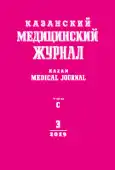Барьеры при оказании фтизиатрической помощи людям, живущим с вирусом иммунодефицита человека, и их преодоление
- Авторы: Загдын З.М.1
-
Учреждения:
- Санкт-Петербургский научно-исследовательский институт фтизиопульмонологии
- Выпуск: Том 100, № 3 (2019)
- Страницы: 482-487
- Тип: Социальная гигиена и организация здравоохранения
- URL: https://journals.rcsi.science/kazanmedj/article/view/13347
- DOI: https://doi.org/10.17816/KMJ2019-482
- ID: 13347
Цитировать
Полный текст
Аннотация
Цель. Изучение мнения специалистов противотуберкулёзных организаций о барьерах и путях улучшения системы противодействия распространению вируса иммунодефицита человека (ВИЧ) и туберкулёза.
Методы. В исследовании использовали анкетирование с открытыми и закрытыми вопросами среди сотрудников фтизиатрических учреждений четырёх территорий Северо-Западного федерального округа (г. Санкт-Петербург, Ленинградская, Архангельская, Калининградская области) в течение 6 мес в 2018 г. Общее количество участников исследования - 284 человека. Анкета состояла из 19 структурированных вопросов. Ответы респондентов сравнивали межтерриториально и оценивали интегрально внутри блоков с вычислением их долевых соотношений.
Результаты. По мнению специалистов противотуберкулёзных организаций, основные барьеры в оказании фтизиатрической помощи людям, живущим с ВИЧ, - низкий уровень межсекторального взаимодействия, миграция, рост количества инъекционных наркопотребителей, недостаточность региональной правительственной поддержки, несоответствие нормативно-правовых актов требованиям сегодняшней реальности. Основными условиями улучшения эпидемической ситуации по сочетанной инфекции ВИЧ/туберкулёз респонденты полагают увеличение охвата пациентов с ВИЧ-инфекцией антиретровирусной терапией, адекватное лечение туберкулёза при ВИЧ-инфекции и усиление информированности населения о ВИЧ-инфекции и туберкулёзе.
Вывод. Улучшить существующую систему противодействия распространению сочетанной инфекции ВИЧ/туберкулёз можно, усилив преемственность в работе между заинтересованными структурами, особенно внутри противотуберкулёзной службы и учреждений в местах лишения свободы, обеспечив полноценный доступ к антиретровирусной терапии, химиопрофилактике и лечению туберкулёза, в том числе путём создания «низкопороговых центров», усиления информированности населения о туберкулёзе и ВИЧ-инфекции.
Ключевые слова
Полный текст
Открыть статью на сайте журналаОб авторах
Зинаида Моисеевна Загдын
Санкт-Петербургский научно-исследовательский институт фтизиопульмонологии
Автор, ответственный за переписку.
Email: dinmetyan@mail.ru
г. Санкт-Петербург, Россия
Список литературы
- Васильева И.А., Белиловский Е.М., Борисов С.Е. и др. Туберкулёз, сочетанный с ВИЧ-инфекцией, в странах мира и в Российской Федерации. Туберкулёз и болезни лёгких. 2017; 95 (9): 8–18. doi: 10.21292/2075-1230-2017-95-9-8-18.
- Нечаева О.Б. Эпидемическая ситуация по туберкулёзу среди лиц с ВИЧ-инфекцией в Российской Федерации. Туберкулёз и болезни лёгких. 2017; 95 (3): 13–19. doi: 10.21292/2075-1230-2017-95-3-13-19.
- Барьеры в доступе к лечению туберкулёза глазами пациентов, живущих с ВИЧ-инфекцией и туберкулёзом в России. https://evanetwork.ru/.../Bareryi-v-dostupe-k-lecheniyu-tuberkuleza-glazami-patsiento (дата обращения: 12.03.2019).
- Zinatsa F., Engelbrecht M., van Rensburg A.J., Kigozi G. Voices from frontline: barriers and strategies to improve tuberculosis infection control in primary health care facilities in South Africa. BMC Health Serv. Res. 2018; 18 (1): 269. doi: 10.1186/s12913-018-3083-0.
- Samrith W., Rahman M., Harun-Or-Rashid M., Sakamoto J. Trends and barriers to HIV testing among tuberculosis patients in Prey Kabas operational district, Takeo province, Cambodia. Asia Pac. J. Pub. H. 2015; 27 (2): NP789–797. doi: 10.1177/1010539512445190.
- Яблонский П.К. Удовлетворённость заинтересованных сторон медицинскими организациями: измерение и анализ по результатам анкетирования, проведённого в государственных стационарных учреждениях здравоохранения Санкт-Петербурга в 2016–2017 годах. Мед. альянс. 2018; (3): 93–101.
Дополнительные файлы






